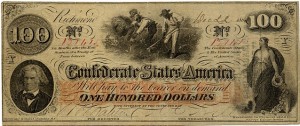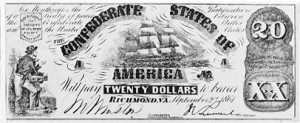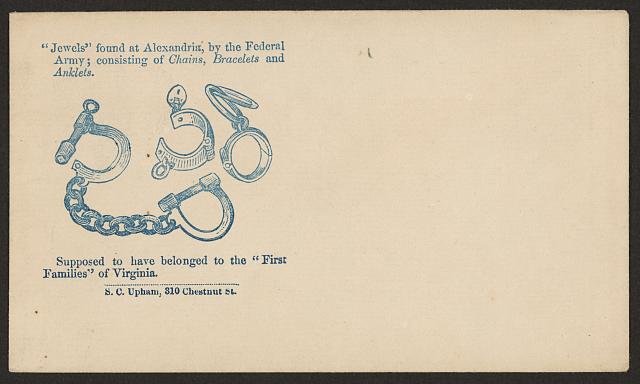Richmond was alive with the “never ending sound” of the Confederate government’s stamping presses manufacturing paper currency. But it wasn’t just the government – counterfeiters were a big problem for the CSA.
From the Richmond Daily Dispatch October 7, 1863:
More New counterfeits.
–The Wilmington (North Carolina)Journal contains a description of two new and dangerous counterfeits. These counterfeits, are especially dangerous; from the fact that spurious issues of one of them were made a year ago or more, and the discrepancies between the genuine and the counterfeit then pointed out by the papers. This new spurious issue has corrected all the errors and variations of the former counterfeits of the same date and denomination. The Journal says:
The first counterfeit is of the denomination of $100, interest bearing note, dated Sept. 1st, 1862, printed by Keatinge & Ball, Columbia, S. C. The second is a Hoyer & Ludwig$20 bill, dated Sept. 2d, 1861.
In the hundred dollar counterfeit the face of Mr. Calhoun, at the lower left hand corner of the bill, is very badly executed, especially the mouth, which looks as if something were held in it causing the lips to protrude. The imprint immediately under is in larger letters than in the genuine, and the b in Columbia is defective, whereas it is perfect in the genuine. In the genuine the line “with interest at two cents per day” is printed on the red shade of the large red word “hundred.” This shade does not show in the counterfeit, or, if at all, too faintly to be noticed. The whole execution of the counterfeit is inferior the that of the genuine, and the note a little smaller. The date of the genuine note is filled in Sept. 1st, that of the counterfeit Sept’r1.
The $20 is more difficult to describe and detect than the $100, and is the most dangerous counterfeit we have ever seen. We have a counterfeit and a genuine bill before us, and save that the counterfeit has been printed with too much ink, and therefore looks much blurred, it would be very difficult to distinguish the one from the other; and we are not sure that this would he a reliable test, as even the genuine bills are not always uniform in color. The only obvious difference is, that in the genuine there is a clear space between the tops of the letters in the word “America” and the waves under the large ship in the centre, whereas in the counterfeit the heads of these letters run quite up to the waves. In the counterfeit we have there is a plain unshaded capital F to the left of the large ornamented letter A, which indicates the issue of the note; in the genuine before us there is none, nor do we recollect to have seen any genuine notes with such letter. In the genuine, just above the letter A, and a little to the right, is the number 23, which is not in the counterfeit.
In an article at EH.net Marc Weidenmier points out that counterfeit currency probably had an impact on the Confederate money supply and the inflation rate. “The Confederacy was unable to curtail counterfeiting because they lacked the resources and equipment to produce high quality money. Counterfeiting was such a widespread problem that people sometimes joked that fake money was of higher quality than government issued currency.” The article discusses Samuel Curtis Upham, a Philadelphian who printed bogus Confederate money between June 1862 and August 1863. It is estimated that Upham printed between 1.0 and 2.5% of the Confederate money supply during that time. The CSA placed a $10,000 bounty on Upham.
You can check out one of Upham’s classified ads in Harper’s Weekly at Son of the South:
Half Price!! Half Price!!
Rebel Notes and P. O. Stamps.
Fourteen different Rebel Notes and Post Office Stamps, sent, post-paid, on receipt of twenty-five cents. Trade supplied at 50 cents per 100, or $4 per 1000. Address S. C. UPHAM, 403 Chestnut Street, Philadelphia.
__________________________________________________



